You’ve made a great choice by investing in beautiful, eco-friendly bamboo tableware. But now you’re worried about keeping it in top condition. The fear of your new bamboo plates warping, utensils cracking, or cutting boards staining after just a few uses is real. Proper care feels like a mystery, and you don’t want your sustainable investment to go to waste.
To properly care for bamboo tableware, you must hand wash it using warm water and a mild dish soap. Immediately dry it with a soft cloth and allow it to air dry completely before storing. Never soak bamboo products in water, and absolutely avoid putting them in the dishwasher or microwave. Occasionally conditioning the bamboo with a food-safe mineral oil will help maintain its natural luster, prevent drying out, and extend its overall lifespan, ensuring it remains both safe and beautiful for years.
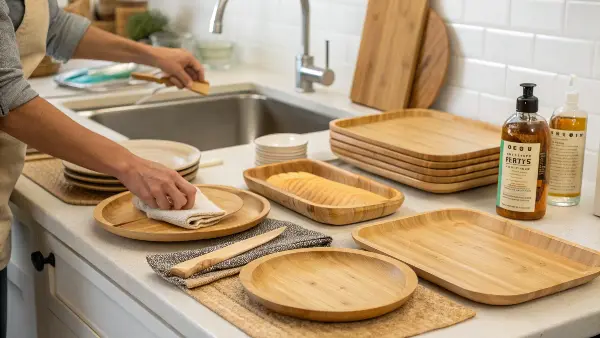
Choosing bamboo is a fantastic step towards sustainability. As a B2B supplier, we talk to clients like you every day who want to make a positive impact without compromising on quality or durability. You want products that not only look good and align with your brand’s values but also last. The good news is, with just a little bit of knowledge, you can ensure your bamboo products perform beautifully for a very long time. Let’s break down the simple but crucial steps to protect your investment and keep your customers happy.
What is the Correct Way to Wash Bamboo Tableware Day-to-Day?
You’ve just finished a meal using your stylish bamboo plates and utensils. Now comes the cleanup, and you want to do it right. It’s tempting to treat them like any other dish, but a little specific care is needed. Using the wrong technique can strip the bamboo’s natural beauty and reduce its durability over time, which is the last thing you want.
The correct way to wash bamboo tableware is by hand, using a soft cloth or sponge with lukewarm water and a gentle, pH-neutral dish soap. Avoid hot water, as it can cause the bamboo fibers to swell and potentially warp or crack. After washing, rinse the items thoroughly to remove all soap residue. This simple routine is the single most important step in preserving the integrity and appearance of your bamboo products for daily use.
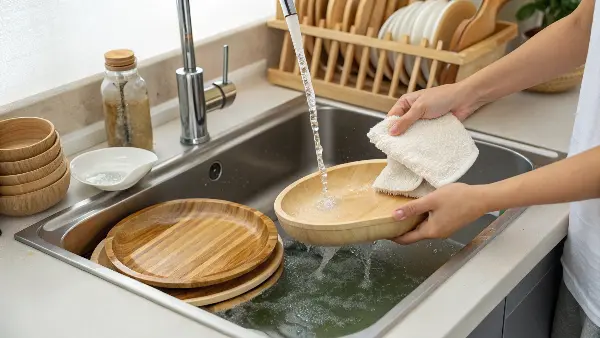
The daily washing routine is the foundation of good bamboo care. Getting this right prevents most common problems before they can even start. As someone who has handled thousands of these products, I can tell you that the right technique makes all the difference. It’s less about hard scrubbing and more about gentle, consistent cleaning. Think of it like caring for a high-quality wooden kitchen tool—it requires a gentle touch.
The Step-by-Step Washing Process
Let’s get specific. The ideal process is straightforward and quick:
- Rinse Immediately: If you can, rinse the bamboo items right after use to prevent food from drying onto the surface. This makes cleaning much easier.
- Use Lukewarm Water: Fill your sink with warm, not scalding hot, water. Extreme temperatures are bamboo’s enemy. High heat can weaken the fibers and, over time, cause the item to lose its shape.
- Apply Mild Soap: Choose a gentle, non-abrasive dish soap. Harsh, chemical-heavy detergents can strip the natural oils from the bamboo, leaving it dry and prone to cracking. A simple, plant-based soap is often a great choice.
- Wash Gently: Use a soft sponge or cloth. Avoid using steel wool, abrasive scouring pads, or stiff-bristled brushes. These will create tiny scratches on the surface, which not only dull the finish but can also become breeding grounds for bacteria.
Here’s a simple breakdown to keep in mind:
| The Right Way (Do’s) | The Wrong Way (Don’ts) |
|---|---|
| Hand wash only | Never use the dishwasher |
| Use lukewarm water | Avoid very hot or boiling water |
| Use mild, gentle soap | Avoid harsh chemical detergents |
| Use a soft cloth or sponge | Avoid abrasive pads or steel wool |
By following this simple routine, you ensure that you’re cleaning your bamboo products effectively without causing any damage. It becomes a quick habit that pays off by keeping your tableware looking pristine and performing reliably for your customers or your own use.
What Common Mistakes Will Ruin Bamboo Products?
You’re already committed to hand washing, which is great. But even with the best intentions, a few common mistakes can silently sabotage the life of your bamboo tableware. You might think soaking a stained plate is a good idea, or maybe you’re just leaving your cutting board to air dry flat on the counter. These seemingly harmless habits are exactly what lead to warped boards, split utensils, and the dreaded appearance of mold.
The most common mistakes that ruin bamboo products are soaking them in water, exposing them to extreme heat in a dishwasher or microwave, and improper drying. Soaking causes bamboo to absorb excess water, leading to swelling, warping, and cracking. High heat from appliances will destroy the material’s integrity almost instantly. Failing to dry items properly after washing creates a damp environment perfect for mold and mildew growth, rendering the item unsafe and unusable.
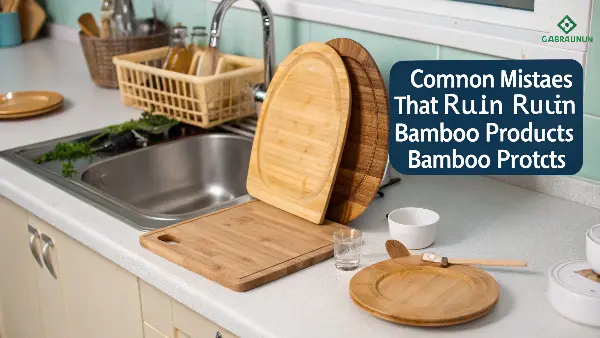
In my experience helping businesses source sustainable goods, I’ve seen firsthand how these simple mistakes can lead to disappointment. A client once called me, frustrated that their beautiful bamboo serving platters had warped after just one event. It turned out the kitchen staff had left them soaking in a sink overnight. This is a common story, but it’s completely avoidable. Understanding why these actions are so damaging is key to preventing them.
The Three Cardinal Sins of Bamboo Care
-
The Deadly Soak: Soaking is the number one enemy of bamboo. Bamboo is a type of grass, and its fibers are highly absorbent. When you leave a bamboo item submerged in water, those fibers drink it all up and swell. When it eventually dries, it does so unevenly. The outer parts shrink faster than the inner parts, creating tension that results in ugly cracks and warping. A quick wash and rinse is all it needs. Never let it sit in water.
-
The Heat Hazard (Dishwashers & Microwaves): This is a non-negotiable rule: keep bamboo out of the dishwasher and microwave.
- Dishwashers: A dishwasher cycle combines two of bamboo’s biggest enemies: prolonged high heat and excessive moisture. This combination will not only warp and crack the bamboo but can also weaken any food-safe adhesive used in laminated products like cutting boards, causing them to delaminate or fall apart.
- Microwaves: Microwaving bamboo is a fire hazard. The small amount of natural moisture within the bamboo’s fibers can superheat, turning to steam and causing the item to crack explosively. At best, it will dry the bamboo out completely, making it brittle and useless.
-
Improper Drying and Storage: After washing, what you do next is just as important. Simply leaving a bamboo plate or cutting board flat on the counter to dry is a recipe for disaster. Water gets trapped underneath, creating a perfect dark, damp environment for mold and mildew to grow. Always dry your bamboo items with a towel first, then stand them on their edge in a dish rack or lean them against a wall so that air can circulate freely around all surfaces. This ensures it dries evenly and completely.
Avoiding these three mistakes will account for 90% of proper bamboo care and will keep your products functional and safe for a long, long time.
How Should You Dry and Store Bamboo Tableware Correctly?
You’ve carefully washed your bamboo items and avoided the big mistakes. But the job isn’t done yet. How you dry and store your bamboo can be the difference between a product that lasts for years and one that develops mold or warps within months. Simply tossing a damp utensil into a drawer or stacking wet plates in a cupboard is asking for trouble.
To dry bamboo tableware correctly, first wipe it down with a clean, dry towel to remove most of the surface water. Then, stand the items on their side in a well-ventilated dish rack or lean them against a surface so air can circulate freely on all sides. For storage, ensure the items are completely dry before placing them in a cool, dry cabinet away from humidity sources like a stove or sink. This prevents trapped moisture, which is the primary cause of mold and warping.
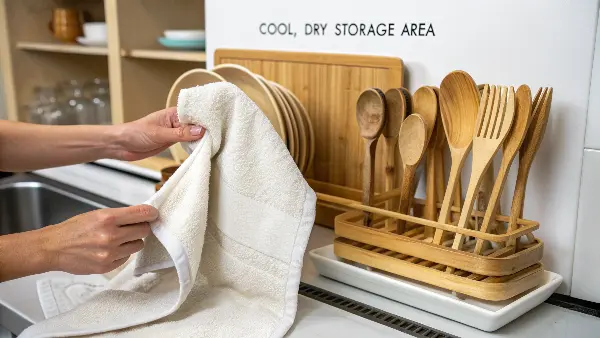
One of the most frequent issues we troubleshoot with new customers is the appearance of small, dark spots—mold. Almost every time, the cause traces back to improper drying and storage. Someone washed a cutting board, laid it flat, and the underside never fully dried. Or they put utensils away while they were still slightly damp. Proper airflow is not just a suggestion; it’s a requirement for maintaining healthy, long-lasting bamboo.
The Two-Step Drying and Storing Method
Think of this as the final, critical phase of your care routine. It’s simple and ensures your bamboo is put away in the best possible condition.
Step 1: Immediate Towel Drying
As soon as you finish rinsing, grab a soft dish towel and give the bamboo item a thorough wipe-down. This removes the excess water from the surface right away. This step is crucial because it significantly cuts down the air-drying time and reduces the total amount of time the bamboo is exposed to moisture. Don’t skip this; it only takes a few seconds and makes a huge difference.
Step 2: Airflow is Everything
After towel-drying, the item might feel dry, but there’s still residual moisture in the fibers. This is where air-drying comes in.
- For Plates and Cutting Boards: Never lay them flat. Stand them up vertically in a dish rack. If you don’t have a rack, lean them against a wall or another object. The key is to allow air to reach the front, back, and edges simultaneously for even drying.
- For Utensils: You can place them in a utensil caddy or stand them in a cup, business-end up, to allow water to drain away and air to circulate.
Proper Storage for Longevity
Once you are 100% certain the bamboo is bone dry (give it at least a few hours of air-drying), you can store it.
- Find a Dry Spot: Store your bamboo items in a cabinet or drawer that is away from any sources of heat or humidity. Avoid the cabinet directly above the stove or next to the dishwasher vent.
- Don’t Seal It: Avoid storing bamboo in airtight plastic containers or sealed bags. Bamboo needs to ‘breathe’ a little to stay stable. A standard, dry kitchen cupboard is the ideal environment.
By making this "towel dry, then air dry" process a habit, you’ll all but eliminate the risk of mold and ensure your bamboo pieces remain flat, straight, and beautiful.
How Can You Recondition Bamboo to Keep It Looking New?
Over time, even with perfect washing and drying habits, you might notice your bamboo products starting to look a little dull or dry. This is completely normal. Frequent washing can slowly diminish the bamboo’s natural oils. You may be wondering if there’s a way to restore that original luster and protect it for the long term, much like seasoning a cast-iron skillet.
To recondition bamboo and keep it looking new, you should apply a thin layer of food-grade mineral oil once a month or whenever it looks dry. First, ensure the item is perfectly clean and completely dry. Using a soft cloth, rub the oil into all surfaces of the bamboo. Let it soak in for several hours or overnight, then wipe away any excess with a clean cloth. This process moisturizes the fibers, creates a protective barrier, and restores the bamboo’s natural sheen.
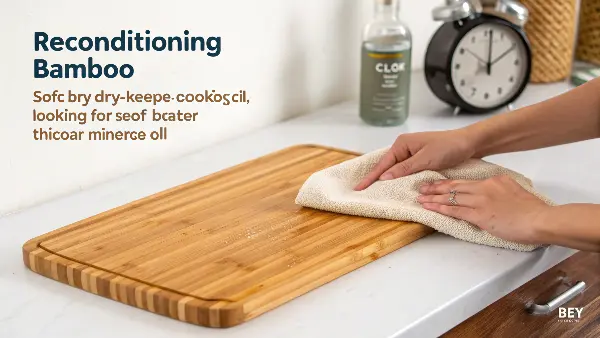
This is the pro-level trick that truly extends the life of bamboo and wooden kitchenware. We always advise our long-term partners, especially those using bamboo cutting boards and serving trays in high-volume settings, to incorporate this into their maintenance schedule. It’s a simple act of preventative care that not only enhances the product’s appearance but also bolsters its natural resistance to water and stains, making it even more durable.
Restoring and Protecting Your Bamboo
Think of oiling as a deep-conditioning treatment for your bamboo. It replenishes the moisture within the fibers and seals the surface. Here’s how to do it effectively.
Choosing the Right Oil:
The most important factor is using an oil that is food-safe and won’t go rancid.
- Food-Grade Mineral Oil: This is the industry standard. It’s inexpensive, readily available, has no smell or taste, and will never spoil.
- Bamboo Conditioning Oil: Many specialized blends are available, which are typically mineral oil-based with added waxes like beeswax or carnauba wax for extra water resistance.
- Fractionated Coconut Oil: Regular coconut oil can go rancid, but fractionated coconut oil has had the long-chain fatty acids removed, making it stable. It’s an excellent plant-based option.
- What to Avoid: Do not use cooking oils like olive oil, vegetable oil, or corn oil. These are organic oils that will oxidize and go rancid over time, creating a sticky surface and a bad smell.
The Oiling Process: A Simple Guide
- Start Clean and Dry: This is critical. Never apply oil to a dirty or damp item. Wash and dry your bamboo product thoroughly as described before, and let it sit for several hours to ensure all moisture has evaporated.
- Apply the Oil: Pour a small amount of your chosen oil onto a clean, soft cloth (not directly onto the bamboo).
- Rub It In: Gently rub the oil into the bamboo, moving in the direction of the grain. Be sure to cover all surfaces, including the sides and edges. The bamboo will start to look richer and darker as it absorbs the oil.
- Let It Soak: This is the most important part. Let the item sit and absorb the oil for at least a few hours. For best results, especially for a first treatment or a very dry item, let it sit overnight.
- Wipe Off the Excess: After it has soaked, use another clean, dry cloth to buff the item and wipe away any oil that hasn’t been absorbed. The surface should feel smooth and hydrated, not greasy.
By doing this simple conditioning treatment every month or two, you’re not just making your bamboo look good; you’re actively extending its life and ensuring it remains a safe, reliable, and sustainable tool in your kitchen.
Conclusion
Caring for bamboo tableware doesn’t have to be complicated. By following these simple but essential steps—hand washing with mild soap, drying immediately and thoroughly, avoiding the dishwasher and microwave, and occasionally treating it with oil—you can easily protect your investment. This ensures your sustainable products remain beautiful, safe, and durable for years to come.


